Publications
International Journal of Algebra and Computation (IJAC)
arXiv.org
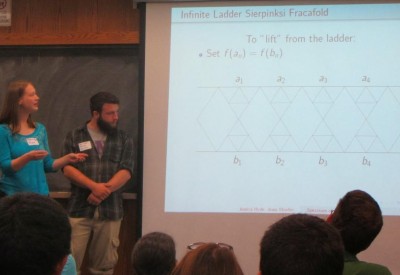
Jessica Hyde, Jesse Moeller, and Luis Seda
One project investigated magnetic gauge fields on the Sierpinski Gasket. After numerical experimentation, using Mathematica and MatLab, this team determined that specific portions of the spectrum of the Laplacian are unaffected by a perturbating magnetic field given by a harmonic 1-form of finite topological type and continued on to prove that this. In a specific case they also gave a description of the spectrum via a covering space and symmetry argument. They presented a poster and a talk on this work at the REU mini-conference at the University of Massachusetts, Amherst and gave a talk at the Young Mathematician’s Conference at Ohio State University.
Spectrum of the Magnetic Laplacian
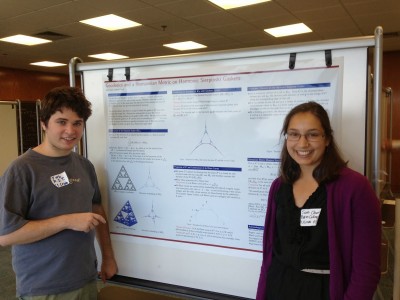
This team worked on the existence of measurable Riemannian structures in the sense of Kigami on higher dimensional Sierpinski-type gaskets. Some time ago, Kusuoka proved existence of a measure, metric (in the Riemannian sense) and gradient operator on a class of fractals that includes these gaskets, such that these objects bear the same relation to the Dirichlet form as do the Riemannian volume, metric and gradient on Euclidean space. Kigami later completed this picture in the case of the usual 3-vertex Sierpinski gasket by constructing a geodesic length that is the analogue of that occuring in the Riemannian case and proving Gaussian heat kernel estimates, and Kajino has subsequently proved very re ned estimates for the heat kernel in this setting. It was believed that although Kigami’s approach relied on certain 2-dimensional techniques the results would also be valid on Sierpinski-type gaskets with more vertices, and that is what our research team have proved. They presented a poster on this work at the REU mini-conference at the University of Massachusetts, Amherst, and are writing the results up for publication.
Geodesics and a Riemannian Metric on Harmonic Sierpinski Gaskets
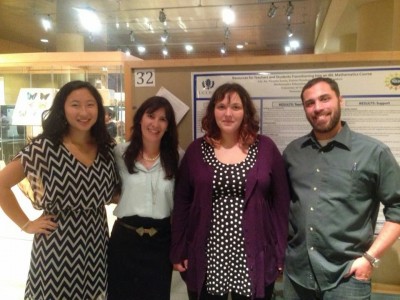
Lily An and Tori Lewis
Gabriel Feinberg and Fabiana Cardetti
This group conducted a research study to create resources to support both instructors and students transition into an Inquiry-based learning (IBL) course. The IBL approach has been shown to deepen student conceptual learning and increase student engagement and motivation in a subject without taking away from procedural understanding. The experiences in an IBL class are significantly different from traditional courses; however, there are few research-based resources to aid instructors and college students adapt to this approach. For this project, the creation of such resources was guided by extensive review of the literature as well as informed by experienced instructors teaching undergraduate mathematics courses and students who had positive and negative experiences in IBL courses. These methods along with the group’s experiences and expertise as instructors and undergraduate students of mathematics helped determine specific aspects that would be most challenging for an instructor, as well as the difficulties students would face, in the transition to an IBL course. The results of this study include a teacher’s and a student’s guide that address those difficulties, provide guidance for each audience, and contribute suggestions to achieve the desired learning outcomes of an IBL course. Lily An presented results at the Women in Mathematics in New England Conference (WIMIN13) on September 21 at Smith College.
Resources for Teachers and Students Transitioning Into an IBL Mathematics Course
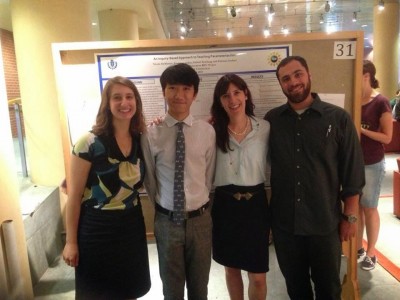
Nicole DeMatteo and Jonathan Dollar
Gabriel Feinberg and Fabiana Cardetti
In the summer of 2012, the UConn Math Education REU team identified parameterization of curves as a challenging topic for students in multivariable calculus courses. Encouraged by the positive research results of inquiry-based learning (IBL) on student performance and attitudes, the research focus for the group in 2013 was to develop IBL curricular materials aimed at supporting student’s understanding of this topic. The group conducted an extensive literature review, studied popular multivariable calculus textbooks, and consulted with experienced instructors to create an original IBL module. The module engages students in collaborative discovery to gain a deep conceptual understanding of parameterization in addition to providing opportunities for procedural practice. In addition, the group developed a detailed guide to support instructors in the effective classroom implementation of the module.
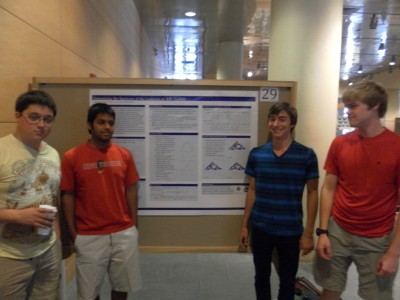
Jason Marsh, Nikhaar Gupta, Max Margenot, and Will Oakley
The Laplacian is the central object of analysis on fractals. While most work on the Laplacian has been focused on computing the Laplacian spectrum on specific fractals, this group instead found the spectrum on an entire class of fractals—the 3N-Gaskets. This is the class of finitely ramified fractal 3N-Gons that are the attractors of iterated function systems containing 3N contraction mappings. For example, the 3-Gasket is the Sierpinski triangle.
The Laplacian on the fractal, and thus its eigenvalues, must be studied by examining the graph Laplacian on approximating graphs. The group found a function R(z) relating the Laplacian eigenvalues on consecutive graph approximations. They used R(z) along with the eigenvalues of the Laplacian on graph approximations to derive part of the spectrum on the next level. The rest of the spectrum was found using an “exceptional set”— a set of values which the group provided for arbitrary N. By repeating this infinitely many times, the spectrum of the Laplacian on the fractal could be found.
Determining the Spectrum of Laplacian on 3N-Gaskets
Poster
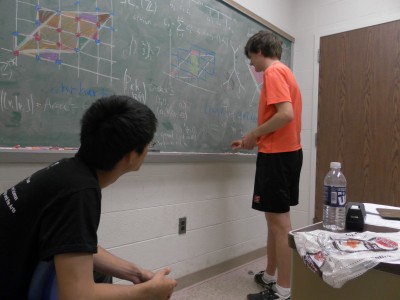
Jed Chou and Ben Whitney
A toric variety is an algebraic variety containing the algebraic torus (C*)n as an open dense subset such that the action of the torus extends to the whole variety. Every n-dimensional toric variety can be associated to a fan, which can be given as a set of primitive vectors in an n-dimensional lattice N. Because of this association, many properties of toric varieties can be studied using combinatorial methods. This group was interested in determining which projective toric varieties are Frobenius split. If a projective toric variety is Frobenius split, it has many nice properties. For example, it can be given as the solution set to homogeneous degree two polynomials.
Sam Payne proved in 2008 that a toric variety is Frobenius split if and only if an associated polytope called the splitting polytope contains representatives of every residue class of (1/q)M/M where M is the dual lattice to N. The group’s goal was to use this characterization of Frobenius splitting to classify the Frobenius split projective toric varieties in n dimensions. Given a trivalent tree where edges are labeled with variables and integers, it’s possible to construct the fan of a toric variety. They determined which toric varieties arising in this way are Frobenius split for certain classes of edge labelings.
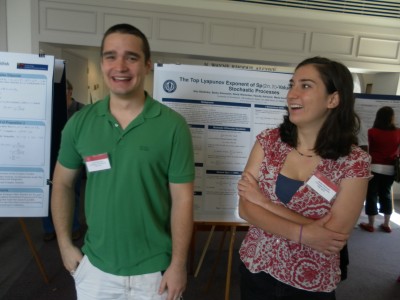
David Wierschen and Becky Simonsen
This group considered the stability of matrix Lie group valued stochastic differential equations, dXt = AXtdt + BXtdt. Random dynamical systems such as this arise in many applications (e.g., oceanic turbulence, helicopter blade motion, light in random channels, wireless networks) in which stability is of practical and theoretical concern. The stability of the zero solution, Xt = 0, is determined by the top Lyapunov exponent. But in practice, analytic calculations of the Lyapunov exponent are often impossible, so time discrete approximations and simulations are necessary. Oceledet’s famous multiplicative ergodic theorem ensures that the Lyapunov exponent of Xt is almost surely constant. But the Lyapunov exponent of a time discrete approximation is itself a random variable. The mean of this random variable has been studied. The group provided estimates on the variance, distribution and rate of convergence in certain numerical approximation methods. In addition, they expanded on and provided simulations for recent results regarding the top Lyapunov exponent of certain Lie group valued SDEs.
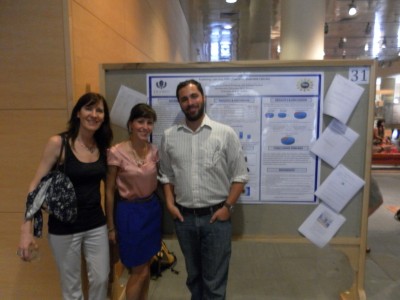
Cathy Matta, Gabriel Feinberg, and Fabiana Cardetti
This pilot study used student perceptions about their understanding of mathematics to guide the development of learning aids for multivariable calculus classes. Studies on the use of computer technology in advanced mathematics classrooms have shown that technology can help with the understanding of abstract concepts (Godaszi, Elahe Aminifar, & Bakhshalizadeh, 2009; Verner, Aroshas, & Berman, 2008). In addition, other researchers have found that using real-world applications and Inquiry Based Learning (IBL) projects can also help students not only with their learning but also with their enjoyment of mathematics (Hassi & Laursen, 2009; Spronken-Smith, Walker, Batchelor, O’Steen, & Angelo, 2012; Stillman, Galbraith, Brown, Edwards, 2007). In this study, these approaches were used in conjunction with students’ perceptions (Pierce, Stacey, & Barkatsas, 2007; Schoenfeld, 1989; Szydlik, 2000) to develop learning aids for multivariable calculus.
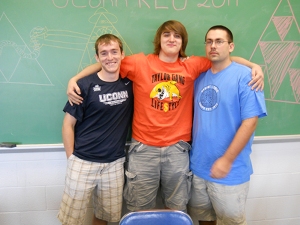
Tyler Reese, Dylan Yott, Antoni Brzoska, and Daniel Kelleher
The brain is one of the most studied and highly complex systems in the biological world. This group analyzed the brain of the nematode Caenorhabditis elegans. They used eigenvalues and eigenvectors of the Laplacian matrix — a matrix representation — of the neural network of the nematode brain with an eye on indicators of self-similarity.
The following is a list of the programs this group used in their research. Most of them were written in Matlab.